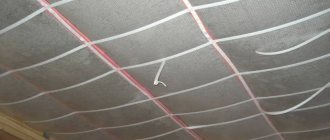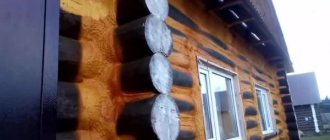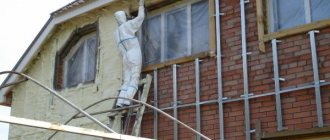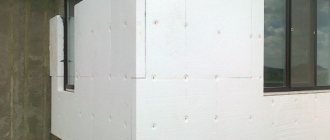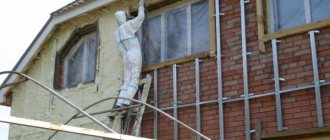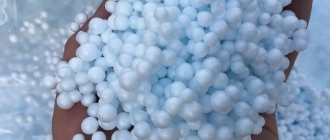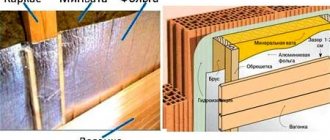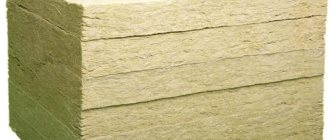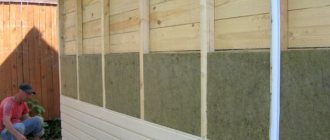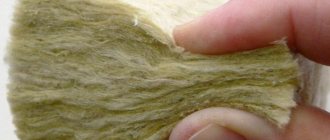Energy prices have been getting higher and higher lately, and effectively insulating a home is one of the main challenges that homeowners have to solve. One of the latest materials that appeared on the market several years ago is polyurethane foam. This is a coating that is applied in a continuous layer to any (almost) surface. Insulation with polyurethane foam is the most effective.
House insulated with polyurethane foam
Features and Specifications
The installed foam insulation is a porous polymer mass.
The working solution is applied under pressure to the wall or ceiling, foams upon contact with air and hardens. Numerous gas bubbles provide thermal insulation and protect the premises from street noise and vibrations. Polyurethane foam, also known as polyurethane foam sealant, is a substance widely used in construction for fastening together individual parts of the connected structure, heat and sound insulation, sealing and filling voids that arise during the work process. Usually sold in metal cans, in which the foam itself and a mixture of liquefied gases are under pressure - the so-called. a propellant that serves as a buoyant force for the contents of the can. The versatility of this synthetic polymer makes it an indispensable assistant in many types of construction work and in almost any repair.
Of course, polyurethane foam sealant has its own characteristics and characteristics, which will be discussed below.
Scope of application
Foam insulation is considered a unique material, since its application in domestic conditions does not require special devices. Using foam, you can easily seal walls, windows and cracks in the roof of your home. The material is also suitable for insulating frame buildings.
Since foam insulation quickly hardens under the influence of the external environment and turns into closed-cell plastic, it is recommended for use for certain types of work.
- Installation and connection of various structural parts . This applies not only to the fastening of frame elements, but also to the installation of garage doors, door and window blocks.
- Isolation of inter-wall space from noise and sounds . This mixture can also be used to insulate the ceiling of a country house or apartment, the installation site of hoods and air conditioners.
- High quality thermal insulation . Foam is used to insulate loggias, balcony structures, garages and hangars. The material is also suitable for insulating facades.
- Sealing . Often the foam mixture is used to repair bathtubs, sealing passages, joints of pipes and engineering systems. Technical voids are filled with material, due to which communications last longer.
High-quality insulation in cylinders: features of polyurethane
PPU is one of the most popular types of thermal insulation materials produced in cans. What else do you need to know about him?
Features and properties of polyurethane foam:
- The qualities of this insulation directly depend on its composition and the additives it contains;
- Using polyurethane, you can quickly and without much difficulty insulate a structure of any configuration;
- This material is not afraid of the chemical effects of alkali or acid, and is able to withstand dampness and is too tough for insects and rodents.
True, as an option you can use “Ekopen” - one of the varieties of polyurethane foam. With its help, you can safely insulate walls and roofs, and with increased vapor permeability. Eco-foam will perform well when insulating ceilings, attic or interfloor ceilings.
But it should be borne in mind that the use of Ecopen is not intended for external insulation of a building without a protective coating, since it is a rather sensitive material to the effects of precipitation and mechanical loads.
Which foam manufacturer is better to choose?
It is best to pay attention to the products of well-known companies that have managed to win the recognition of users with their many years of work.
The most popular companies can be considered:
- A well-known brand with several factories in Europe. All products meet high standards and are tested immediately before being released for sale. Even with prolonged use, this material does not darken, retains its dimensions, and also copes with its main task.
- In all possible ratings of manufacturers, this company consistently holds bronze. This brand's mixture foams without third-party intervention, which significantly improves ease of use.
- The company has long been producing high-quality mixtures with high performance indicators. Users also note the cost-effectiveness of this solution when processing large areas.
- A universal product with a uniform structure and a sufficient level of density. Fills all seams and cavities, providing high-quality protection from the cold.
- The moment of installation. An affordable solution with good characteristics from a domestic supplier.
- A popular product with high fire resistance. Suitable for insulating windows and doors. And its relatively low cost makes it one of the most attractive options.
Stages of roof insulation with polyurethane foam
When applying the coating, you must follow the technology and sequence of work
Necessary tools and protective measures
To work you will need:
- reusable and or disposable spraying installation;
- mounting knife for cutting rolled and sheet materials and removing frozen excess foam;
- measuring tool for marking surfaces;
- painter's protective overalls with a hood and elasticated arms;
- tight shoes;
- safety glasses or face shield;
- respirator;
- gloves.
Preparatory work
During preparation, it is necessary to clean the surface to be treated from debris, dirt and remnants of old coatings.
Next, install the sheathing and metal profiles or wooden slats. Their thickness should match the planned thickness of the applied foam layer. In the future, the finishing trim will be attached to this frame.
The working solution is thoroughly mixed to the consistency required in the instructions.
Spraying material onto the base
The first layer of foam is applied to the prepared base. It is necessary to achieve a continuous application, closing gaps and filling uneven areas.
Spraying is done from top to bottom. If necessary, after the first layer has hardened, apply the second and subsequent layers. Each time you need to let the previous layer dry and set.
Excess insulation is cut off with a mounting knife flush with the installed sheathing.
If you plan to cover the insulation with a layer of plaster, a polymer or metal reinforcing mesh is mounted on the sheathing.
Application of fire retardant composition
Polyurethane foam is highly flammable and releases toxic substances when heated and burned. Therefore, the insulation layer is coated with a fire retardant compound. The composition must be selected specifically recommended for use together with polyurethane foam. It would be wise to choose it from the same manufacturer as the main material. The layer is applied with a sprayer or roller so that the coating is continuous and the entire insulation is protected.
Tips and tricks for use
The use of foam heat insulators requires a preliminary analysis of surfaces, their operating conditions and the degree of vapor permeability. This is an important point, since errors in the choice of material can lead not only to the opposite effect, but also to the destruction of walls or other structures of the house. You need to learn the rule - foam can only be applied to impermeable materials, for example, metal roofing or OSB (if a frame house is being insulated). In such cases, it does not matter whether the material is applied internally or externally.
If foam must be applied to permeable walls (concrete, brick, cinder block, etc.), then external insulation with polyurethane foam or other types of foam is prohibited (with the exception of permeable penoizol). If you plan to install foam from the inside, you must immediately provide high-quality ventilation to remove moist air.
Sometimes it is mistakenly believed that foam cannot be installed only in heated rooms, and for unheated rooms this restriction does not apply. Therefore, insulation of an attic or other similar area of the house can be done in any way you like, the main thing is to carefully and evenly apply a continuous layer of foam.
This belief becomes the cause of serious mistakes, leading to the need to redo the work or create additional systems and conduct communications. It is necessary to take into account that insulation of unheated rooms is useless in itself, since there is no thermal energy that must be conserved.
Application
After about 30 cm, stop and see what layer of foam forms. If necessary, apply a little more foam on top of the first layer.
Over time, you will develop an understanding of the optimal amount of solution to spray.
But for pouring, it will be very problematic to correctly distribute the foam evenly throughout the entire space. The fact is that, in theory, you should first pour in the liquid, and then it, expanding, gradually becomes foam.
But the catch is that it is almost impossible to perform this procedure, since you cannot see what is happening inside. That is why it is recommended to install the hose in such a position that it points straight down, and then start pouring. So, the liquid will first fill all the cracks and niches from below, after which, expanding, it will move upward.
Prices, characteristics, types of equipment for applying raw materials
To apply insulating raw materials, you can use several available means, which differ in price, purpose, and number of times of use. There are devices that are wise to purchase only when working in the construction industry and in constant use.
Disposable tool
Products for one-time use are assembled at the factory - simultaneously a cylinder with insulation and a device for application. Such products are easy, convenient to use, and do not require careful preparation of the surface.
The foam composition fits well on the walls, and after use the product does not need to be washed or preserved - you can immediately throw away the used cylinder.
Single use kit
The combination of foam with a distribution device falls into the category of budget products.
Bottles are produced in a strictly fixed volume, with restrictions on the coverage area. It is necessary to correctly calculate the consumption of raw materials so that there is enough to process the wall at one time and there is no surplus left.
How to effectively perform insulation with balloon material can be seen in the following video:
Rechargeable devices
There is complex equipment that is supposed to be used when working with viscous substances. Compared to professional tools, the complexes are limited in resources and productivity.
The devices facilitate independent regulation of the density, the type of heat-insulating mixture used, and the pumping of a strictly defined amount of liquid into the cylinders.
ProtonHome
Popular representatives of rechargeable installations include Proton Home, costing from 25,000 rubles. The equipment helps to effectively apply coating, regardless of the degree of density, delivering a productivity of 2 kg of liquid mixture in 1 minute. With an application layer thickness of 2 cm, it will be possible to treat 25-30 square meters. m of base.
In terms of shelter area, Proton costs approximately 560 rubles. The disadvantage of such savings is the impossibility of fine adjustment.
Air-Light
A more productive type of device is Air Light, which processes up to 4 kg of solution in 1 minute. The product belongs to the category of universal rechargeable devices that allow you to work equally successfully with built-in cylinders and barrels with a volume of 100-200 liters.
Mobile device
For more convenient operation, manufacturers have created a frame by which you can push the device, firmly place it, and wheels on which it can easily move.
The price of such mobile equipment starts from 80,000 rubles.
Foam Kit 600
Set of products Fom Kit 600 for distribution of 56 sq. m of facing material is a representative of disposable pre-configured components.
The starting price of the new device is 35,000 rubles.
The complete kit includes items for applying thermal insulation: replacement nozzles for the gun, protective gloves, main tanks, hose.
Material characteristics
Polyurethane foam (PPU) looks like a homogeneous structure of foam material, consisting of air bubbles filled with gas. Various versions of polyurethane foam are deservedly popular because they can be manufactured directly on the construction site. The most common method is to apply the material to the surface by spraying. Spraying is used for thermal insulation of houses, industrial workshops, pipelines, and in addition, it is actively used in the interior of premises.
Filling is used when it is necessary to fill a cavity between walls or a gap between installed finishing layers.
The thermal conductivity coefficient of the material is 0.023-0.025 W/mS. Teplis heat insulator is lightweight and can be easily applied to surfaces made of any materials (concrete, brick, glass, wood, aluminum, PVC).
Thanks to the optimal ratio of open and closed cells in the structure, the insulation “breathes”. Accordingly, the treated surface always remains clean and dry.
Other product benefits include:
- resistance to temperature changes;
- environmental friendliness;
- duration of operation (at least 20 years);
- seamless application, eliminating the formation of cold bridges;
- good sound insulation;
- low flammability;
- immunity from harmful rodents and insects.
Teplis polyurethane insulation is sold in 1 liter cylinders. Included with this product, the manufacturer offers to purchase a mounting gun with nozzles for uniform spraying.
Basement of a house with sprayed insulation applied
Is it possible to insulate walls with foam?
Polyurethane foam is often used during construction work. This material is chosen for prompt and effective insulation of house walls. It is important to minimize the number of seams and carefully handle cold areas. Complete and careful sealing of the surface will become the basis for creating a comfortable indoor climate.
Insulation of walls from the outside
Insulating external walls with foam is a common task during the construction or renovation of a private home. In this case, it is important to observe the dew point, taking into account which will ensure dry and warm walls for many years. A careful approach to external insulation of the walls of a house with foam will allow you to achieve a high level of energy savings, preserve the footage of the room, get rid of condensation, and also improve sound insulation performance.
The disadvantages of such a solution include impressive implementation costs, including the work of craftsmen and the rental or purchase of special equipment. But even similar costs for insulating facades with foam will quickly pay off due to savings on heating.
Indoors
The walls of the room are insulated from the inside with foam only if it is not possible to carry out the plan from the outside. This applies to work with apartments in multi-storey buildings.
The insulation process shifts the dew point, so special attention must be paid to waterproofing. Neglecting this recommendation can lead to moisture condensation on the walls, fungus, or even destruction.
Features of insulation of various structures
Depending on the surface being treated, the order of the measures taken may be different. The advantage of polyurethane foam insulation is that it can be used for both horizontal and vertical elements. Insulating a house with foam has a high degree of adhesion to the surface, since the material penetrates into the most inaccessible places.
Insulation of floors
Can be done both from below and from above. For flooring above a cold basement, the most appropriate option would be to insulate the floor from below. Polyurethane foam is practically the only insulation that is convenient to work with in these conditions. To protect the attic floor, polyurethane foam is applied from the cold attic side.
Waterproofing and vapor barrier are not required during operation. It is recommended to carry out installation in the following order, regardless of whether insulation is performed from above or below:
- removing dirt and dust from the surface being treated;
- to increase adhesion, you can treat the surface with a primer;
- nailing slats or profiles, installing floor joists, between which heat insulation is sprayed;
- filling the space between the profiles with expanded polystyrene;
- finishing the ceiling or installing a clean floor.
Wall insulation
Insulation of walls with foam can be done from the outside and from the inside. External thermal insulation would be a smart solution, but if necessary, internal work is allowed, for example, with additional insulation after the facility is put into operation. The only differences are in the finishing.
The work is performed in the following order:
- surface preparation, cleaning from dirt and dust;
- marking the wall and installing vertical sheathing;
- filling the space between the frame with foam;
- installation of the facing layer.
Mansard roof
Insulating the space between the rafters with foam will allow you to choose the pitch of the rafters regardless of the dimensions of the material, as is the case with mineral wool. The insulation is installed in the following order:
- installation of elements of the rafter system and roofing;
- cleaning the base;
- spraying polyurethane foam between the rafters from the eaves to the ridge;
- installation of sheathing;
- ceiling cladding, such as plasterboard.
Application conditions and surface preparation
Even with good adhesion, which is characteristic of polyurethane foam insulation, surface preparation will not be superfluous. First of all, you need to remove everything that is crumbling - and first of all the old paint. Grease stains must also be removed and neutralized. They shouldn't exist.
Polyurethane foam is applied to dry, grease-free surfaces
Everything that should not be covered with foam should be covered with polyethylene secured with tape. It must be secured carefully, without gaps - it is difficult to remove the foam.
When insulating a roof with polyurethane foam, there are two ways to apply thermal insulation. The first is to make a permanent continuous sheathing onto which foam is poured. The second is to make a temporary frame consisting of two parallel planes.
If the outer walls of a building are insulated with polyurethane foam, a finishing finish is assumed. And after cleaning the surface, you need to make sure that you can strengthen it with something - it won’t work with foam. To do this, most often, wooden or metal strips are placed on the walls, to which the exterior trim is then attached. This completes the preparation. But applying polyurethane foam is only possible on a completely dry surface, at temperatures above +10°C. There are no other conditions.
Kinds
It's no secret that modern insulation manufacturers offer the widest range of sealants to choose from. Let's together try to understand the abundance of types of polyurethane foam and see which types of the required substance will best serve a particular purpose.
Polyurethane foam differs in several ways.
Type
Household
Pros: no special equipment is required to work with household foam. It can be easily distinguished from a professional one by the external type of can: at the end of the container there is a special valve on which a lever with a plastic tube is attached.
Cons: can only be used to fill small voids or cracks; it is not used for installation, since it almost always requires trimming - the volume of this type of sealant is usually higher than the volume of the space it fills.
Professional
Pros: higher coefficient of primary expansion than the previous type, increased elasticity and finer structure. The supply of material can be controlled, so it is placed more accurately than household material, evenly filling the required volume. It is also impossible not to mention that professional polyurethane foam can be easily attached to almost any surface.
Cons: A nail gun is required for a professional look. However, given the versatility and wide scope of application, this minus is very relative.
By temperature of use
Summer
Summer polyurethane foam is recommended for use at positive temperatures – from approximately +5 to +30. At low ambient temperatures, the yield of useful substances from the can decreases, and the degree of expansion drops significantly. Work at elevated temperatures should also not be carried out due to the characteristics of the prepolymer, whose viscosity in such cases is significantly reduced.
Winter
Typically used at temperatures from -10 to +40 degrees. However, there are some types of foam that allow you to work even at -20 - for example, Tytan Professional 65 sealant. After hardening, the winter type can easily withstand temperatures of seventy degrees. Suitable for a barrel in which any substance can be stored.
All-season (or universal)
In fact, it has almost the same temperature range as winter and is not always classified as a separate group. Work with it is carried out at temperatures from -15 to +30 degrees.
By the number of components in the can
One-component
It is quite widespread and has a relatively low cost. The polymerization reaction occurs with the help of water. The shelf life does not exceed one year.
Pros: low cost, ready for use immediately after purchase, easy to use.
Cons: short shelf life.
Two-component (structural)
Water does not take part in the reaction. It is replaced by a special component, which is located in a small hermetically sealed container inside the cylinder itself. Its cost is higher than that of a single-component one and, as a rule, it is sold in small-volume cylinders (usually 220 ml), because the solidification time of the substance after mixing the components is short and amounts to ten minutes.
Pros: neat filling of voids.
Disadvantages: high cost; when producing a polyurethane mixture, it is necessary to strictly adhere to the established proportions.
According to the degree of flammability
- Class B1 – fire-resistant and fire-resistant. It usually comes in a pink or bright red hue - dyes are added specifically so that when applied, the type of composition is immediately visible.
- Class B2 - self-extinguishing, as the name implies, it does not support combustion.
- Class B3 – combustible PPU foam with zero fire resistance. Reviews are mostly positive.
Reviews
Recently, most builders have chosen foam as the main insulation material. They attribute this to the high performance characteristics of the material. Judging by the reviews, the foam is easy to install, so it can be used at home to insulate balconies or loggias. The material has proven itself not only as a heat insulator, but also as an excellent fixative . Therefore, most homeowners, when carrying out repairs, choose it for attaching door and window blocks.
Residents of apartments in multi-storey buildings, where not only heat but also sound insulation is important, are also satisfied with polyurethane foam. Thanks to its unique structure, the mixture adheres tightly to the surface of the walls and ceiling, reliably protecting them from the penetration of extraneous noise. In addition, many consider the main advantage of foam to be its strength and long service life.
Advantages and disadvantages of this type of insulation
The undeniable advantages of the substance in question, which the manufacturer usually indicates on the packaging, include:
- high degree of adhesion - that is, its ability to firmly attach to many surfaces. The exceptions are Teflon, silicone, ice, polyethylene and oily surfaces;
- heat resistance (usually ranges from -45 °C to 90 °C);
- cured polyurethane foam is a dielectric (does not conduct electric current);
- fairly fast hardening speed - from eight minutes to a day;
- high moisture resistance;
- lack of toxicity (of course, after final hardening);
- a small percentage of shrinkage (no more than 5%) throughout the entire period of operation;
- chemical resistance;
- high strength;
- long service life of the material (up to half a century).
Also no less important characteristics are:
- The total volume of sealant output is calculated in liters and refers to the amount of foam coming out of a unit of container. This characteristic is affected by ambient temperature, humidity and windiness.
- Viscosity mostly depends on air temperature. Temperatures above (or below) certain limits specified for each type of foam will negatively affect the viscosity of the substance. This is bad for masonry.
- Primary and secondary expansion. Primary expansion is the ability of the composition to expand immediately after leaving the cylinder in a very short time interval (up to sixty seconds). In this short period of time, polyurethane foam sealant is able to increase in volume by 20-40 times. Secondary expansion refers to the ability of a synthetic polymer to expand for a long time before polymerization finally stops.
High-quality polyurethane foam has a pleasant light yellow or slightly greenish color; it does not flow down when applied to the surface and is even suitable for the roof. It is not eaten by rodents and insects, and does not harm the environment. When hardened, the substance turns into a durable, porous, seamless material that is quite moisture-resistant and has excellent insulating properties.
It is important to note that under the influence of solar ultraviolet radiation, this insulating material is subject to rapid destruction - first it darkens and then becomes brittle. Never forget to plaster the foam-filled area after it has hardened.
Otherwise, it may simply turn into dust.
Polyurethane foam is suitable for insulating a frame house. It will serve as a special air gap.
Experts' estimates vary, so let's try to draw a line and compare all the pros and cons.
Advantages
- The porous structure prevents the accumulation of steam inside penoizol.
- Significant service life - from 50 to 60 years.
- Prevents the colonization of microbes and rodents, does not rot.
- Not subject to spontaneous combustion.
- Resistant to hazardous environmental influences.
- Possibility of quick installation.
- Does not release toxic substances after hardening.
- Insulation can be done with your own hands.
Minuses
- It takes a long time to dry. Complete drying of a not too thick layer takes at least two days.
- During polymerization, harmful formaldehyde is released.
- Does not adhere well to dirty surfaces.
- If necessary, dismantling the coating is very difficult.
- During the cold season, working with this material becomes very difficult.
| Application thickness, cm | Price in rub. per cube, density 36 kg/m3 | Price in rub. per cube, density 53 kg/m3 |
| 3 | 450 | 800 |
| 6 | 900 | 1550 |
| 10 | 1500 | 2600 |
Insulation using ready-made sheets:
| Slab thickness. cm | Price in rub. for 1 m2 |
| 10 | 1200 |
| 15 | 1800 |
| 20 | 2300 |
Insulation by pouring method:
| Type of work | price, rub. for 1 m3 |
| Pouring on the object under construction or into existing holes | 1500 |
| Filling with drilling | 1500 200 per hole |
As you can see, foam is not an inexpensive method of insulation, but taking into account the subsequent savings on heating and the speed of application, it is possible to reduce the overall cost of building a building. In addition, the price may be partially covered when carrying out insulation work with your own hands.
Cylinder assembly
It is best to carry out insulation with this type of insulation in small areas, because its use in large areas is not always economically feasible.
The reason here is that polyurethane foam is sold mainly in small volume containers, approximately 200 and a maximum of 750 ml.
The largest of them are inexpensive, but they are enough to process only 1 square meter. m of any surface, but taking into account that the layer will be applied no thicker than 8 cm.
After insulation with this material, the thermal insulation of the surface will be several times lower in comparison with the use of the other two types of foam. The reason is that in such insulation half of the cells remain open, whereas in the same polyurethane foam the number of closed pores reaches 90%.
The process of foaming polyurethane foam occurs due to the fact that it is supplied to the surface under high pressure.
In addition, this process intensifies after the material reacts with moisture in the air.
The use of this insulation is common for sealing both window frames and during the installation of doors. It is also advisable to insulate the walls of a small area, for example, a loggia or closed balcony.
This insulation has a more complex composition than classic polyurethane foam.
It is produced in the form of slabs, which is somewhat similar to classic polystyrene foam.
Being in this form, it is more protected from external factors for storage and transportation.
But to bring it into a liquid state at the point of use, a special device is used. It not only melts penoizol, but also mixes it with resin. When insulating walls using such insulation with your own hands, you use a special construction gun.
Foaming begins inside this device and then it is applied to the surface, where it hardens after 15 minutes. For the material to completely harden, you need to wait several days.
Due to the fact that it has a long period of complete hardening, brick-type walls are most often insulated with foam insulation. The material is also often used for thermal insulation of formwork, as well as for insulation of frame houses.
Good to know: due to the fact that the composition of penoizol includes urea and formaldehyde, a significant number of people believe that this insulation is harmful to health. In fact, this is not so, all these components are removed, so the material is harmless to people.
Features of insulation
To independently insulate a house with foam, you need a protective suit. Foam is usually sprayed from a can onto the entire surface of the facade; it fills the voids between walls, rafters, and beams.
There are many advantages to this type of wall insulation with foam in the air gap. The main ones include:
- vapor permeability;
- fire resistance;
- ability to increase in volume;
- resistance to various types of mechanical stress;
- the upper temperature limit remains within +80 degrees.
Foam is often used to seal cracks that remain after installing plastic windows. Due to this, the thermal insulation in the apartment also increases. It is convenient to use a pneumatic gun for insulating not only windows and external walls, but also foundations, loggias and balconies, and pipes.
After treatment with foam insulation for walls, the facade turns out perfect - without visible joints or seams. One cylinder contains on average 600-700 ml of the composition, which is enough to treat a square meter with a layer up to eight centimeters thick. Operating such a gun is very simple: first, a full cylinder is inserted into it, then you need to point it at the surface to be treated and pull the trigger. On average, the applied composition hardens within 24 hours.
Foam for waterproofing
Foam is often used to protect against moisture. Under the influence of water, it begins to increase in volume and harden within 24 hours. Such products are sold in cans. The peculiarity of such foam is its fixing and waterproofing features. Used for work outside and inside.
We can say that foam as insulation is an excellent solution. It has a lot of advantages and is a universal solution. Sometimes other insulation materials other than foam cannot be used. Therefore, if funds allow, you can hire professionals who will quickly and efficiently do all the work for you.
Types of material and their properties
Foam heat insulators vary in their composition and application method
Liquid penoizol
This popular material is used to insulate floors and walls. It has the following advantages:
- high-quality adhesion to most building materials;
- small amount of preparatory work;
- seamless and jointless coating;
- good vapor permeability;
- high penetrating ability;
- possibility of filling hard-to-reach volumes;
- resistance to fungus, microorganisms and mold;
- environmental friendliness.
The material also has disadvantages:
- linear shrinkage;
- strong unpleasant odor during application;
- hygroscopicity, additional water vapor barrier is required;
- fire hazard; when heated, toxic substances are released.
Roof insulation can be done using liquid penoizol.
Penoizol requires an additional fire retardant coating; it is better to use it for external insulation of the roof of a house.
Polyurethane foam (PPU)
Closed-cell polyurethane foam insulation is also deservedly popular among homeowners. Experts highlight the following advantages inherent in the material:
- applicability over a wide temperature range;
- compatibility with most popular building materials;
- ensuring the tightness of the sprayed coating even with a complex roof configuration;
- low thermal conductivity coefficient;
- resistance to biological influences: mold, microorganisms, insects, rodents;
- low density of the material and, accordingly, a small additional load on the roof;
- resistance to solvents and other active substances;
- ability to withstand compressive and tensile loads;
- low vapor permeability, no need for additional vapor barrier;
- minimal hygroscopicity;
- excellent noise insulation performance;
- long service life comparable to the service life of insulated structures.
There are PPUs and a number of disadvantages:
- high activity of the working staff, harm to exposed skin and respiratory organs;
- the need to use protective clothing, masks and respirators;
- vulnerability to sunlight, especially ultraviolet rays, necessitates protecting the coating with an additional layer of mastic or plaster;
- releases harmful substances when heated;
- highly qualified worker applying the coating is required;
- high cost of equipment for applying the material.
The last two factors make it difficult to apply polyurethane foam yourself. Even disposable installations, already charged with a certain volume of working solution, are expensive. If the home owner does not have experience in successfully using them, it is better to turn to professionals and insulate the roof with their help. You will be able to save your nerves, money and time.
Other advantages
- The hardened structure of the material with pores also seems to be an excellent material for sound insulation.
- The material is light enough, it will not exert any noticeable load on building structures.
- Many of these insulating materials, after final polymerization, become completely safe for people, animals and nature. They do not become infected with fungi or mold, and they are not of interest to mice, rats or insects.
- Most of the insulating foam has excellent contact with the structural and metal elements of the building, not only forms a thermal insulation layer for them, but also creates good protection against rust. Most materials of this type exhibit excellent waterproofing properties, preventing vapor or water from penetrating. When insulating walls, roofs or ceilings, it eliminates the need to install special gaskets.
Types of foam insulation
There are 3 types of foam:
- Assembly room.
- Polyurethane, consisting of 2 substances.
- Liquid polystyrene foam - penoizol.
Other types, the packaging of which clearly indicates the scope of application.
Polyurethane foam in cylinders
This is a one-component thermal insulator. Insulation can be carried out independently.
Types of polyurethane foam:
- façade – having a large temperature range. It can withstand minus and plus temperatures;
- ordinary - for sealing cracks, sealing seams;
- with special strength;
- glue-foam.
A construction gun is used to apply the material.
Penoizol
Penoizol is similar to polyurethane foam, but it has a different composition. It has a low level of density, does not allow cold, sounds, or moisture to pass through. It is most often used to insulate houses.
To apply the material you need equipment and dry, warm weather. After completing the work, it takes 5 days for complete drying, only finishing work is carried out with topcoat.
Spray polyurethane foam
Polyurethane foam consists of 2 substances. This is the best material for thermal insulation of a building. Cylinder equipment is used for installation. The material on the surface hardens within 10-20 minutes. The structure is closed cells that have minimal thermal conductivity, noise insulation, and moisture penetration.
One layer of applied material is 6 cm thick. Sometimes after complete hardening, a 2nd layer is applied for strength.
Scheme
An important point in the construction of buildings is the insulation of walls with foam using a special technology that provides for two installation schemes: external and internal.
If you do all the work yourself, then first you need to lay polystyrene foam on the outside. Then high-quality waterproofing is installed from the inside, after which everything is sealed with foam insulation.
When carrying out external insulation, it is necessary to completely eliminate the appearance of an air gap, otherwise condensation will collect on the surface, and fungus or mold will appear in the future.
To do this, foam is applied to walls lined with polystyrene foam from a can by spraying. The mixture should be applied evenly to the surface.
Is penoizol harmful to health?
After testing, Russian manufacturers were convinced of the safety of using penoizol. There are certificates confirming this. But polystyrene foam is prohibited in Canada and is not used in the USA as insulation. In the UK, safety guidelines are followed regarding the use of urea foam as a toxic substance. The problem lies in the concentration of formaldehyde, which is released during polymerization. At high concentrations in the air it causes allergies and tumors in the future
Therefore, it is very important to use high-quality materials and adherence to pouring technology. In high-quality products and in the hands of craftsmen, the minimum content of formaldehyde is safe
Is foam plastic harmful?
In conditions of increased competition in the construction market, material manufacturers act in two ways. In the first case, they try to create a better product or introduce it into the construction industry with better quality. The second case falls into the category of “black” competition, where provocative slogans are invented for rivals’ products.
One of the results of the malignant rivalry was the creation of myths that foamed raw materials are harmful in composition and regularly release toxic substances.
Nothing like this happens, but all synthetic products have a drawback - during the combustion process, in the event of a fire, the material will emit acrid smoke. Such emissions into the air contain toxic volatile compounds created on the basis of formaldehyde resins.
When applying foam, it is recommended to use protective equipment; until the surface of the insulation has completely hardened, there is an increased risk of contact with a small amount of inert gases or other chemical compounds.
What is better - penoizol or polyurethane foam?
In order to understand which material is of the highest quality and strongest, it is necessary to compare them.
Thermal conductivity when installing installation insulation.
In this case, polyurethane foam takes first place, since its coefficient is higher than that of penoizol.
Density.
Foam also wins. Unlike penoizol, it is harder and has a structure of increased density.
Resistant to liquids.
Due to the high density of the PPU foam material, liquid does not allow liquid to penetrate into its structure; the first material, on the contrary, is prone to exposure to moisture and its absorption.
Resistant to fire.
Penoizol is a material that does not ignite at all, and foam is susceptible to melting and releasing harmful substances.
Life time.
In this category, both materials are equal; their optimal service life is about 50 years.
Price.
Penoizol is slightly cheaper than PPU foam.
Cutting off excess material for further processing.
Manufacturers and prices
There are many manufacturers of foam thermal insulators. This is a modern, promising material that is of interest to all specialized companies. Among the leading manufacturers are:
- VASmann;
- Sipur;
- Polynor;
- Penoplex;
- TechnoNIKOL;
- Profur;
- Penosil, etc.
VASmann
Sipur Polynor
Penoplex TechnoNIKOL
Profur
Penosil
Listing manufacturers will not provide useful information, since there are many of them and they all produce a large number of varieties of foam for insulation. Prices for the material vary - polyurethane foam costs about 3000-5000 rubles per cubic meter, foam in liter cylinders costs from 350 to 550 rubles. If you order application from specialized organizations, the costs will be even higher, since the price of work and overhead costs will be added to the cost of the material. However, this option is considered more preferable, since the work will be performed by specialists who guarantee the result.
Insulation process
Do-it-yourself foam coating is within the capabilities of a home DIYer with basic spray painting skills. When working with entry-level household installations, as a rule, one person can handle it. When installing sheathing and when working with high-performance devices with long hoses, an assistant will be required to carry them, as well as move containers with components.
Preparing to start work
Before you begin, you need to prepare the surface for coating. You should remove old wallpaper, paint and anything that might prevent the foam from adhering to the surface.
Next, in increments of 50 cm, vertical guides are attached to the wall - wooden blocks or a metal profile. They are designed for fastening finishing materials - drywall, lining or others. If there is no decorative coating, the guides are not installed and the foam is sprayed in a continuous layer.
All work on laying communications - electrical and pipelines - must be completed before spraying begins. It is recommended to lay wires in corrugated plastic or metal sleeves.
Before you start covering the wall with foam, you should also make sure that there are no air bubbles left in the hoses and cylinders.
Continuous wall covering
Is it possible to insulate with foam yourself?
Basically, they carry out internal thermal insulation work on their own. For this you need:
- Wooden slats or metal profiles as guides for sheathing.
- Foam cans and a construction gun.
- Construction knife.
First, the surface in the house is cleaned of dust, flowers, and cobwebs. After this, the profiles are fixed in increments of 50 cm vertically along the wall, with horizontal jumpers of 50 cm.
- Safety precautions: glasses, protective clothing, gloves.
- Apply a little automotive lubricant to the construction gun for better performance.
- Insert the can into the gun.
- Apply foam to the surface.
Insulation with polyurethane foam in St. Petersburg and the Leningrad region
recommends insulation only with proven imported environmentally friendly, harmless materials. Don’t skimp on your own health and take care of the health of your loved ones! Choose the pleasure of comfort in a warm and safe home, rather than the disappointment of low-quality fakes.
Thermal insulation. How to properly make thermal insulation? Thermal insulation PPU
Waterproofing. What is waterproofing? Waterproofing with polyurethane foam (liquid waterproofing)
Noise insulation. What is sound insulation?
External insulation. How is external insulation performed? External insulation with polyurethane foam
Internal insulation. Insulation from the inside with polyurethane foam
Seamless insulation. Insulation with polyurethane foam (PPU) without seams
Spray insulation. How is insulation produced by spraying polyurethane foam? Insulation by spraying polyurethane foam
Liquid thermal insulation. What is thermal insulation by liquid spray polyurethane foam?
Turnkey insulation. We insulate houses, cottages, buildings and structures on a turnkey basis. Professional turnkey insulation
Insulation with polyurethane foam (PPU) is one of the most effective ways of thermal insulation of walls, roof, floor and foundation of a building. It forms a seamless coating on any uneven surface, protects walls and roofs from heat loss and wetness, and allows you to quickly cover large areas of different rooms with insulation. offers reliable thermal insulation of houses and apartments in St. Petersburg and the region. We guarantee the quality of spraying, timely order fulfillment and durability of the thermal insulation.
PPU: advantages and features of insulation
Polyurethane foam has long been used in insulation. A new technology for its application - spraying - has improved the usual insulation, made the foam “flexible”, and made the adhesion to a wall or other surface reliable and strong. What are the advantages of insulation using the PU foam spraying method?
- The uniqueness of the insulation - polyurethane foam provides heat, steam, electrical, and noise insulation properties of walls, foundations and roofs (for steam and waterproofing, polyurethane foam with a closed cell structure is used).
- The spraying method allows for high-quality insulation of any uneven surfaces. In this case, a high adhesion density is formed, resulting in an even, seamless coating.
- Can be applied to any surface: wood, brick, concrete, glass, metal, paint. It is applied to ceilings and floors, curved and curved arches, walls, corrugated sheets, pipes, domes, tanks.
- Polyurethane foam insulation is quick to apply. In one team of workers of 3 people will spray an area of 400 square meters. m.
- Long service life - from 30 years.
Where can PPU be used?
- Insulation of walls, foundations, roofs, floor slabs and floors in residential and public buildings, industrial premises, basements, warehouses and livestock farms.
- On heating mains - to reduce heat loss.
- Any containers, refrigerators and freezers (to insulate the chamber from heat).
- Parts and components of cars, railway cars, airplanes.
PPU technology
Insulation with polyurethane is carried out by spraying. To do this, a special installation is used that dispenses the components, heats them, and mixes them to produce polyurethane foam with certain characteristics (density, thermal insulation coefficient). The application technology consists of the following operations:
- The mixture is supplied under pressure through a spray gun (aerosol torch).
- When sprayed, liquid polyurethane foam fills any gaps, joints, cracks, and levels out various level transitions (sills, steps). After spraying the liquid mixture, hardening occurs (within 1 minute).
- PU is applied in several layers. The thickness of each of them is 30-40 mm. The lower layers are made with a lower density (indicators are regulated by automatic equipment when feeding the mixture and mixing the components). Outer layers of insulation are made with greater density to protect against mechanical stress and moisture penetration.
Disadvantages of use
Despite all the positive qualities, foam also has some disadvantages. Fortunately, there are not as many of them as there are advantages. But this fact cannot be ignored. This information will make it possible to avoid some mistakes.
The main disadvantages of the material:
- Polyurethane foam is not highly resistant to UV radiation. Usually, after sealing defects in the wall with it, you have to additionally finish the surface with slabs. This helps protect the material from sunlight, which causes the destruction of polymers.
- The cost of industrial foam is quite high. Now there are many varieties of it, which have different properties. Even in small cylinders, foam for wall insulation is not that cheap. If you plan to work with large areas and damage, you will have to take several cylinders.
Taking into account all the positive and negative qualities, everyone will be able to choose for themselves the best insulation option that will reliably protect the house and have a long service life.
Thermal insulation paint
Insulating foam is not the only thermal insulation product that has a liquid consistency. Along with it, liquid ceramic paint is used. Compared to foam, this paint has less pronounced thermal insulation qualities. At the same time, the latter has better waterproofing properties.
It is recommended to apply paint only at the junctions of structural elements of a residential building, for example, between the roof and walls. Some people use this material to insulate rooms from the inside, but this is a big mistake. On the one hand, to achieve the desired thermal insulation effect, you will need at least 10 layers of paint. On the other hand, the thermal insulation layer is never placed on the inside of the walls, since this will lead to the formation of condensation in the building due to an incorrectly calculated dew point.
Spraying and pouring polyurethane foam (PPU)
If you are currently building a house, then think carefully about its insulation. First of all, think about how much of your future non-guaranteed income will come from heating bills.
Now is the time to make a smart decision - major insulation of your property. It’s better to spend money once and then save for the rest of your life than to save once and then heat the street and pay big bills.
Polyurethane foam - we look into the future with optimism.
With the existing variety of thermal insulation materials, I would immediately like to note the fact that they all have two major drawbacks: fasteners and joints.
In order for the insulation to EFFECTIVELY fulfill its purpose, it must be attached to the surface to be insulated so that there is no air gap left between it and the surface.
Condensation moisture appears precisely in the layer between the insulation and the surface, because This is where the boundary between heat and cold lies.
When installing sheet insulation, special attention should be paid to cracks and joints, otherwise the expenses and labor will be in vain. Moisture will still appear. And moisture means damp walls, increased heat loss and the appearance of mold and mildew.
This is the dew point.
Laying roll insulation on horizontal and inclined surfaces also does not help the situation. It is no coincidence that various vapor barrier materials are included with them. Without these materials, such insulation would quickly become saturated with moisture, cease to perform its function, and collapse within a few years.
But vapor barrier does not solve the problem - it just pushes it back in time. It was created precisely in order to extend the life of mineral wool.
As for curved surfaces (corrugated sheets, metal tiles), it is simply pointless to insulate them with sheet material, and insulating them with rolled material is ineffective due to the same dew point.
After 5-7 years, you can safely open such surfaces and throw away the insulation. Tested in practice. Anyone can verify this by watching videos on the Internet.
Massive advertising of mineral wool manufacturers did its job. This so-called insulation, not created for our climate, has won its share of the market. And sales are based only on the lack of knowledge of physics among our population at the 7th grade level.
You and I do not live in America or Europe, here the climate is different and the requirements for insulation are different.
How does Russia insulate itself?
When property owners are faced with the question of insulation, they have to choose between polystyrene foam, mineral wool or basalt fiber.
Recently, pouring penoizol into the ventilation gap of brickwork has become popular. This once again confirms the fact of blatant technical illiteracy of both customers and performers. The components of Penoizol contain a large amount of water, which remains in the material for a very long time, negating the thermal insulation properties of Penoizol. When drying, Penoizol cracks, forming straight bridges of cold.
In general, people without special education (and these are the absolute majority), when faced with the problem of insulation, use everyday logic. The essence of this logic is to compare insulation with winter clothing. Which is fundamentally wrong.
What do we wear in winter? Sheepskin coats and down jackets.
What protects us from the cold? An air layer that is located between the fibers of wool, down or padding polyester.
Mineral wool and basalt insulation consist of almost the same fibers, and if they are sewn into fiberglass, then this is a real down jacket.
The analogy is inaccurate.
We periodically take off our clothes, excess moisture evaporates, and it is impossible to remove the insulation. Insufficient thickness of the insulation leads to freezing and accumulation of moisture, which destroys both the insulation itself and the surface, which turns from heat-insulating to heat-conducting, which further aggravates the situation. But property owners don't know about this. In 90% of cases, the insulation is not available for control. Some actions begin only after the appearance of mold and mildew.
Why is this happening? Air is the best insulation after vacuum. But STILL air. If the structure of the insulation is such that air flows pass through it, such “insulation” must be protected from saturation with moisture. For our climate, the thickness of such insulation should be at least 20 cm, with double protection and an air gap in front of the outer cladding. 5-7 cm of hard polyurethane foam is sufficient without additional measures.
Foam plastic (expanded polystyrene)
- Article about teaching staff
- Comparison and calculations
Consists of granules foamed under the influence of high temperature.
Thanks to its low cost, it has gained popularity, especially in the Samara region, where one of the largest PPS production plants is located.
Density - from 15 to 40 kg/cub.m.
Thermal conductivity coefficient - 0.04 W/m*
Moisture absorption coefficient - 3-5%
Effective service life is from 5 to 10 years.
It is used everywhere, from insulating balconies to facades of multi-storey buildings.
Almost all modern new buildings are insulated with 10 cm thick EPS, followed by finishing with facade plaster.
Why? Because it's cheap. And because the construction company is then not responsible for anything.
Thermal insulation of a house using foam
Thermal insulation work is one of the most important stages of construction. This applies to technical structures and residential buildings. High-quality insulation can significantly reduce energy costs and extend the service life of walls and finishing materials.
Thermal insulation with polyurethane foam (PPU) came to the construction market recently, but quickly gained popularity among specialists and customers. This technology can significantly reduce the time required to carry out work. Polyurethane foam can be used as insulation on any surface, as it has high adhesion rates and has virtually no restrictions.
Wall insulation can be done in three ways:
The method is selected based on the individual characteristics of the premises and calculation of the cost of work. But each of the listed methods has its own characteristic nuances that must be taken into account. Spraying and insulation with slabs is carried out both outside and inside the house. And the filling is carried out in the air space between the parts of the partition, which is specially left at the construction stage.
1. Spraying technology.
Thanks to its high adhesion, polyurethane foam instantly adheres to the base and creates a uniform layer in which there are no areas of cold inherent in most types of thermal insulation. Insulation with foam by spraying is carried out using special equipment. It can be professional, and is used repeatedly, as well as disposable, which is quite suitable for DIY work.
If it is necessary to insulate a small room, for example, a loggia in an apartment, foam from ordinary cylinders is often used. It is slightly different in consistency, but at the base it contains the same polyurethane. The application technology is similar to spraying with professional devices used by specialists, but it is much slower due to the low pressure in the cylinder. Polyurethane foam has a higher cost, but it is offset by the fact that you do not need to buy equipment.
- As a result of expansion, it completely fills the insulated area.
- There is no need to level the walls before application.
- High speed of work performed.
- Relatively high cost.
2. Filling technology.
If the house is at the construction stage and polyurethane foam is chosen, a special wall design is required, which provides an internal empty space where the foam is filled. But even if the house has already been completely built, thermal insulation is possible through special technological holes that are drilled in several places and foam is injected through them. The device supplies insulation through hoses inserted inside the wall. After the material has completely hardened, dense thermal insulation is obtained, eliminating air chambers.
- Has the highest rates of efficiency and energy saving.
- The interior space is completely preserved and no additional exterior finishing is required.
- Do-it-yourself insulation with polyurethane foam by filling is impossible without specialized equipment.
- Injection through holes does not prevent the formation of air bubbles inside.
- The pressure that polyurethane foam creates during expansion can damage walls if the house is made of poor quality materials.
Foam is presented not only in a liquid state, but also in the form of finished slabs. Insulation is carried out by gluing segments to the surface and fixing them with dowels with a wide head. Unlike spraying, this process does not require special equipment and can be done with your own hands.
To prevent the insulation from accumulating condensation, before installation the surface must be treated with impregnations that prevent the appearance of mold and mildew. This should be done regardless of which side the house is insulated from. At the final stage, polyurethane foam from a balloon is filled into the seams. Thus, the thermal insulation becomes monolithic.
- Lowest cost among other methods.
- Ease of installation.
- Insulation with polyurethane foam boards is not as effective in terms of energy saving.
- The house needs decorative finishing.
- For installation, it is necessary to first level the surface, otherwise the insulation will lie unevenly.
- Foam in slabs has a lower degree of durability.
Penoizol has a similar structure to polyurethane foam, but differs in technical characteristics. According to the standards, in premises with increased requirements for fire and environmental safety, such as:
- Public places.
- Kindergartens and schools.
- Medical institutions.
Insulation with polyurethane foam is prohibited due to the easy flammability and toxicity of products released as a result of combustion. This applies to both the slab and liquid versions. Fire safety rules allow the use of polyurethane only in private construction or in the construction of non-residential premises.
In turn, penoizol meets all standards and has no restrictions on use. It is made on the basis of a complex chemical compound - urea-formaldehyde. This is a white porous material with a lot of air bubbles. The main advantage of spraying penoizol over polyurethane is that it does not support combustion at all, and at high temperatures it breaks down into carbon dioxide, nitrogen and water. The absence of toxic emissions allows the use of this insulation in any premises, regardless of their intended purpose.
Properties
The main characteristic of insulation is thermal conductivity. The lower it is, the better the thermal insulation. And PPU has one of the lowest.
According to Table T1 from the reference appendix to SP 50.13330.2012, the thermal conductivity of polyurethane foam in a dry state is as follows:
- for a density of 40 kg/m3 - 0.029 W/m*°C;
- for a density of 60 kg/m3 - 0.035 W/m*°C.
Note. In real conditions, the thermal conductivity of materials is higher, and it depends on its own humidity.
Closed-cell polyurethane foam has low vapor permeability and moisture absorption, but even in this case, when making calculations, allowances are made for operating conditions (according to standard: A or B).
The only competitor to polyurethane foam in this parameter is extruded polystyrene foam.
Its thermal conductivity is:
- for density 25-33 kg/m3 - 0.029 W/m*°C;
- for a density of 35-45 kg/m3 - 0.03 W/m*°C.
